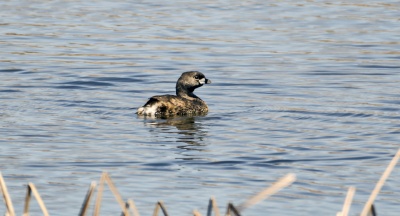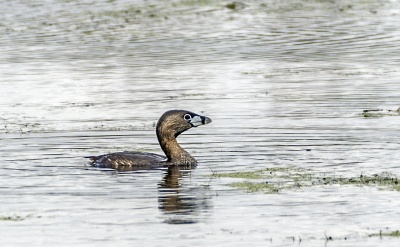Difference between revisions of "Grebes"
Ken Czworka (talk | contribs) (→Pied-Billed Grebe) |
Ken Czworka (talk | contribs) (→Horned Grebe) |
||
| Line 14: | Line 14: | ||
=== Horned Grebe === | === Horned Grebe === | ||
(Podiceps auritus) | (Podiceps auritus) | ||
| − | + | ||
| + | A small, compact waterbird with a compact body, relatively short neck, blocky head (sometimes peaked), and straight, narrow bill, very unlike a duck's bill. | ||
| + | Breeding adults are dark gray-black on the back with rich rusty-cinnamon sides and neck. The head is gray-black with long yellow tufts behind the eye. Nonbreeding birds are monochromatic: grayish above with white underparts. The head is capped in black with a sharp transition to white on the cheek. | ||
| + | Horned Grebes are almost always seen on the water, where they make fairly brief dives in pursuit of fish and invertebrates. Breeding birds feed heavily on insects and larvae, some caught in the air, others in or on the water. Wintering and migrating birds usually form small flocks. | ||
| + | Breeds on freshwater ponds with emergent vegetation. On migration and in winter occurs in lakes, ponds, rivers, bays, and oceans. | ||
| + | |||
=== Red-Necked Grebe === | === Red-Necked Grebe === | ||
(Podiceps grisegena) | (Podiceps grisegena) | ||
Revision as of 23:32, 11 February 2022
|
|
Pied-Billed Grebe
(Podilymbus podiceps)
COMMON: Migrates south for winter. Seen regularly in suitable habitat throughout Western New York during the spring, summer and fall months. Pied-billed Grebes are small, chunky swimming birds. They have compact bodies and slender necks, with relatively large, blocky heads and short, thick bills. They have virtually no tail. These are brown birds, slightly darker above and more tawny-brown on the underparts. During spring and summer, the crown and nape are dark and the throat is black. While breeding, the bill is whitish with a black band (“pied’), but otherwise is yellow-brown. Juveniles have striped faces. Pied-billed Grebes can adjust their buoyancy and often use this ability to float with just the upper half of the head above the water. They catch small fish and invertebrates by diving or simply slowly submerging. They build floating nests of cattails, grasses, and other vegetation. Look for Pied-billed Grebes on small, quiet ponds and marshes where thick vegetation grows out of the water. In winter they occur on larger water bodies, occasionally in large groups.
Horned Grebe
(Podiceps auritus)
A small, compact waterbird with a compact body, relatively short neck, blocky head (sometimes peaked), and straight, narrow bill, very unlike a duck's bill. Breeding adults are dark gray-black on the back with rich rusty-cinnamon sides and neck. The head is gray-black with long yellow tufts behind the eye. Nonbreeding birds are monochromatic: grayish above with white underparts. The head is capped in black with a sharp transition to white on the cheek. Horned Grebes are almost always seen on the water, where they make fairly brief dives in pursuit of fish and invertebrates. Breeding birds feed heavily on insects and larvae, some caught in the air, others in or on the water. Wintering and migrating birds usually form small flocks. Breeds on freshwater ponds with emergent vegetation. On migration and in winter occurs in lakes, ponds, rivers, bays, and oceans.
Red-Necked Grebe
(Podiceps grisegena)

